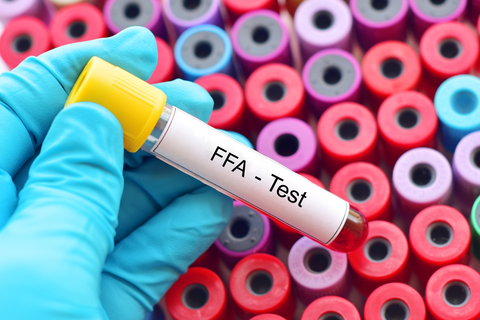NIST Standard Reference Material Supports Clinical Tests for Common Chronic Diseases
SRM 3951 Fatty Acid Species in Frozen Human Serum

NIST has developed its first reference material to aid in the measurement of free fatty acids in human blood serum.
Most adults who routinely monitor their health have a regular lipid assessment, which measures triglycerides, or fatty acids bound to glyceride molecules, along with cholesterol. In recent years, researchers and clinicians have become interested in measuring fatty acids floating free—unbound to glycerides—in whole blood, blood plasma or blood serum. Free fatty acids are a source fuel for the body, but an overabundance may be an indicator of conditions including uncontrolled diabetes mellitus, cardiac disease, dementia, and rheumatoid arthritis.
The NIST team repurposed human serum that had been collected a decade ago in order to develop a reference material for measurements of vitamin B12. While the levels of the vitamin were not high enough to make a successful reference material, the preserved serum proved suitable for measurements of free fatty acids in a 2017 interlaboratory study organized by NIST in collaboration with the National Institutes of Health Office of Dietary Supplements. That interlab study, in which 14 labs measured free and total fatty acids in the same materials, is just one part of the NIST Quality Assurance Program offerings. The 2017 program is no longer active, but future fatty acids studies will be run through the Clinical Measurements Quality Assurance Program (ClinQAP). Clinical labs participate in such studies, submitting their measurement data to NIST for analysis, to assess their performance against other participating laboratories and NIST values, where appropriate and available. NIST conducts such studies to better understand the needs of the clinical testing community, and determine areas where NIST can best provide feedback, education, or reference materials. (For more information on NIST QAPs, please contact QAPHUB [at] nist.gov (QAPHUB[at]nist[dot]gov).)
NIST used the same measurement technique, gas chromatography with mass spectrometry, that researchers are likely to use with SRM 3951 as a control material to validate their specific methods for determining free and total fatty acids in human serum.
NIST provides certified values, meaning that NIST has the highest confidence that all known or suspected sources of measurement bias have been evaluated, for these six free fatty acids:
- Myristic acid
- Palmitic acid
- Palmitoleic acid
- Stearic acid
- Oleic acid
- Linoleic acid
NIST provides non-certified values and uncertainty estimates for five additional free fatty acids and 23 total fatty acids in SRM 3951.
A unit of SRM 3951 consists of three vials of frozen serum with each vial containing approximately 1.0 mL of serum. It must be stored at or below - 70 °C.

